Exam 3: Assertiveness in Communication
1/49
There's no tags or description
Looks like no tags are added yet.
Name | Mastery | Learn | Test | Matching | Spaced |
|---|
No study sessions yet.
50 Terms
It is Important to recognize our ________________________ in communication
own natural tendencies
Examples of styles in which we communicate: (4)
- Passive (non-assertive)
- Aggressive
- Passive-agressive
- Assertive- our goal
Assertion
- Involves __________, but not __________
- Understands that all have the right to be __________________
- Recognizes that we are responsible for our own ____________ and ______________
- Involves respect, but not deference (submission)
- Understands that all have the right to be respected
- Recognizes that we responsible for our own feelings and actions (and not that of others)
Assertive people have....
clear boundaries
• They are clear about who they are and how they feel
• They are clear about when their rights are being violated
Passive Communication Style has a tendency to do what?
judge and blame self - feel bad about self. 'I'm not ok - You're ok'
- Tends towards being self-critical, self-blaming, under-functioning
Passive Community Style (5)
• Compliant, 'people-pleasing'
• Emotional distancing- silence, withdrawal
• Softly spoken, mumbling or apologetic
• Vague
• Wary, watchful of self
Aggressive Communication Style has a tendency to...
judge and blame other person - feel annoyed with others. 'I'm not ok - You're not ok'
- Tends towards being perfectionist, overly critical, over-functioning
Aggressive Communication Style (6)
• Critical, blaming
• 'You made me feel...'
• Ineffective fighting
• Venting feelings, lashing out
• 'High Standards', demanding
• Overbearing, opinionated
The 2 types of respect involved in assertiveness
- Respect for oneself- expressing one's needs and defending one's rights
- Respect for the other person
Nonassertive people don't _______________
respect themselves
Why might nonassertive people be dishonest or hesitant to reveal the truth?
Because they don't believe they have the right to express their own thoughts and feelings
Nonassertive people can be expressed as...
passive-aggressive or manipulative behavior
- because of their lack of respect for their own rights
Passive-aggressive behavior
Individuals express negativity or anger indirectly, often through sarcasm, subtle digs, or other indirect behaviors, while appearing outwardly calm or submissive
What does nonassertive behavior often encourage? Why?
the inappropriate behavior of others
- because inappropriate behavior is not challenged
Aggressive people don't _____________
respect others
Aggressive people are:
- Willing to......
- May be ________, ____________, and generally attempt to ___________________
- They need to be ________, and often will not acknowledge the validity of ______________, _____, or _________
- Often use _________, __________, _________, and ________________ in their communication with others
- violate the rights of others in order to meet their own needs
- may be loud, interrupt others, and generally attempt to dominate conversations
- They need to be right, and often will not acknowledge the validity of different opinions, values, or ideas
- Often use blaming, criticism, sarcasm, threats, and name-calling in their communication with others
Assertive people ________________________
respect themselves and others
Assertive people
- Respect _________, but also expect to be _____________
- Are ______________
- Own their own ___________, ________, and ________
- Willing to ___________ and __________ communicate their ______________, __________, and __________
- Willing to communicate when they do not feel ____________ or they believe that _____________ have been violated
- respect others, but also expect to be respected
- are courageous
- own their own feelings, thoughts, and ideas
- Willing to openly and honestly communicate their feelings, opinions, and needs
- Willing to communicate when they do not feel respected or they believe that boundaries have been violated
Passive vs. Aggressive vs. Assertive chart
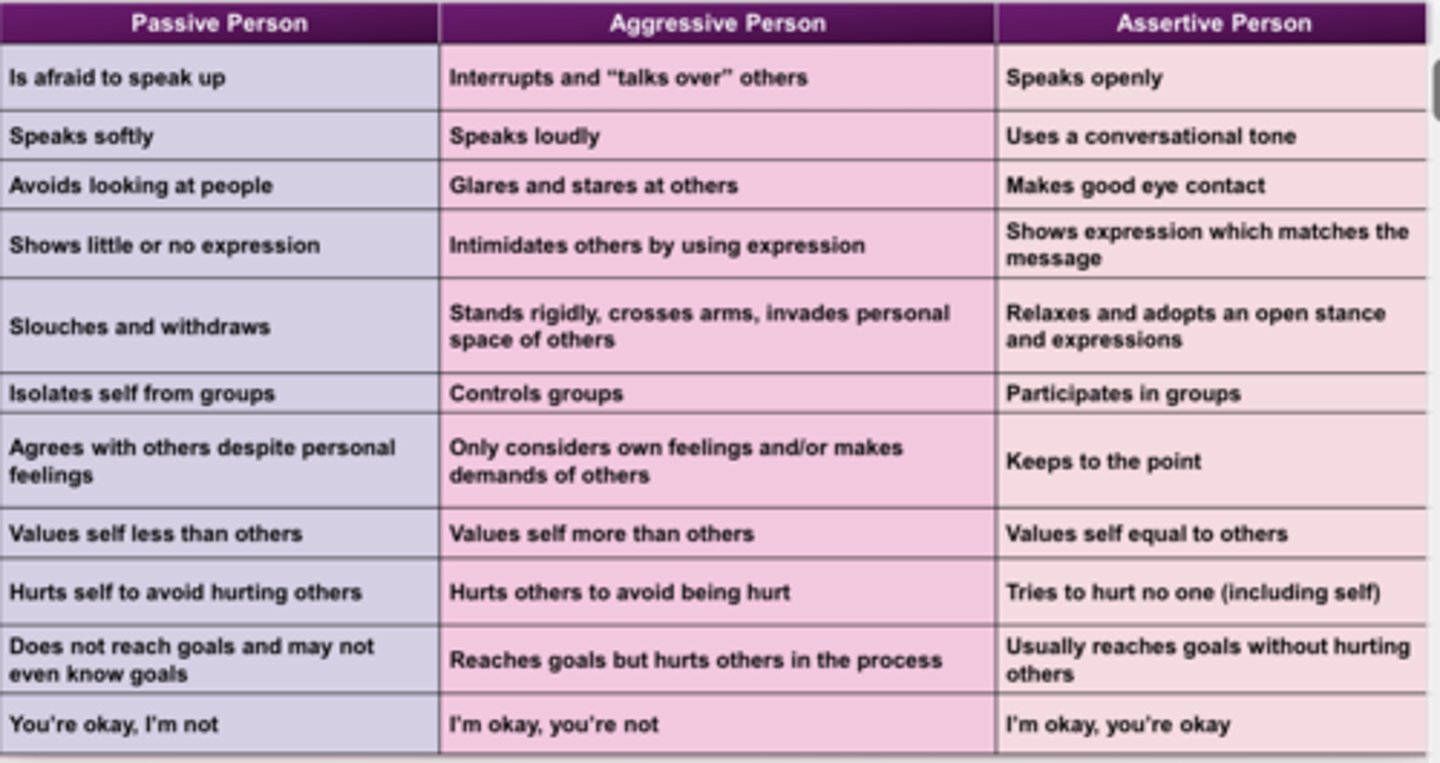
What is a hallmark of practicing being assertive?
Making "I" statements
What do "I" statements cause us/force us to do?
- "I" statements cause us to take responsibility for our feelings, ideas, and needs
- "I" statements often force us to "look inside" and decide what the issues are
Making "I" statements means being...
responsible for oneself
Making "I" statements allows us to come to the realization that....
we cannot change other people's behaviors
- we can only change our response and communicate what we need
It is important to use "I" statements to...(4)
- Respond in a way that will de-escalate conflict- avoid using "you" statements that will escalate conflict
- Identify feelings
- Identify behaviors that are causing the conflict
- individuals resolve the present conflict and prevent future conflicts
Examples of "I" Statements chart
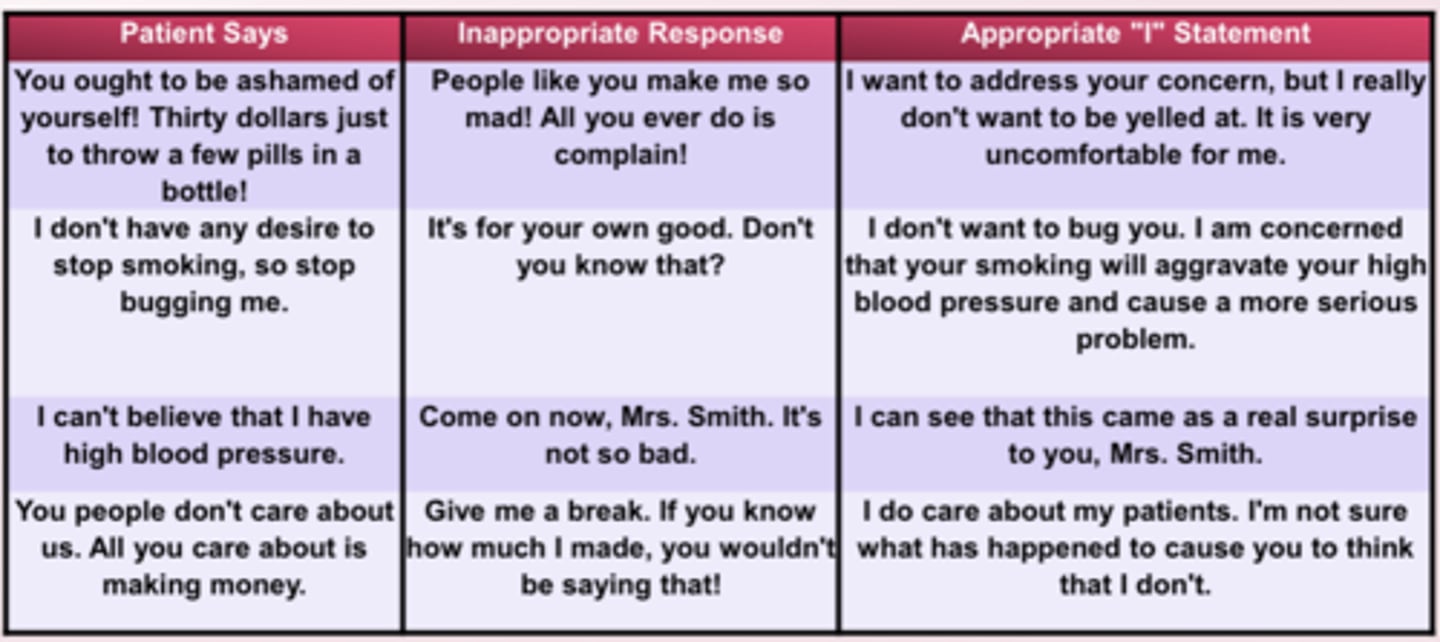
Husband gets silent instead of saying what's on his mind. Wife says, "I get the feeling that you're uncomfortable talking about what's bothering you. I think we can work that out if you tell me what's irritating you."
Identify whether the statement is....
- Nonassertive (or passive)
- Aggressive
- Assertive
Assertive
You'd like a raise and say, "Uh, do you think that you could consider giving me a raise?"
Identify whether the statement is....
- Nonassertive (or passive)
- Aggressive
- Assertive
Nonassertive or passive
A co-worker approaches you while you are busy and asks for help with a task. You respond "You always approach me at the last minute when you need help and expect me to drop everything and help you, but you never help me when I need help. So, no, I will not help you now."
Identify whether the statement is....
- Nonassertive (or passive)
- Aggressive
- Assertive
Aggressive
You've been talking for a while with a friend on the telephone. You would like to end the conversation and you say, "I'm terribly sorry, but my supper is burning and I haveto get off the phone. I hope you don't mind."
Identify whether the statement is....
- Nonassertive (or passive)
- Aggressive
- Assertive
Nonassertive (or passive)
At a meeting, one person often interrupts you when you're speaking. You calmly say, "Excuse me, I would like to finish my statement."
Identify whether the statement is....
- Nonassertive (or passive)
- Aggressive
- Assertive
Assertive
A student responds to a fellow classmate, "You really frustrate me when you forget our deadlines and make our projects late. Why can't you just get the work done on time?"
Identify whether the statement is....
- Nonassertive (or passive)
- Aggressive
- Assertive
Aggressive
To communicate effectively during your consultations with pts, stay in an....
assertive mode
Assertiveness: Present your views in a ____________ and ___________ fashion
- forthright and confident
People do not usually have a high level of __________________ in a nonassertive speaker
confidence
Conversely, they are frequently offended by....
aggression
Some misconceptions about assertiveness: (2)
- some think that assertive people tend to be rude, impolite, pushy, and uncaring
- a truly assertive communicator is none of these
Assertion is not....(6)
- aggressive
- hostile
- confrontational
- ambiguous
- demeaning
- condescending
The strategies that can help you be more assertive (8)
o Broken record
o Fogging
o Negative inquiry
o Workable compromise
o Sorting issues
o Disarming anger
o Selective ignoring
o Assertive withdrawal
Broken record
- use calm repetition
- saying what you want over and over again
- allows you to be persistent in your communication without having to rehearse arguments or angry feelings beforehand
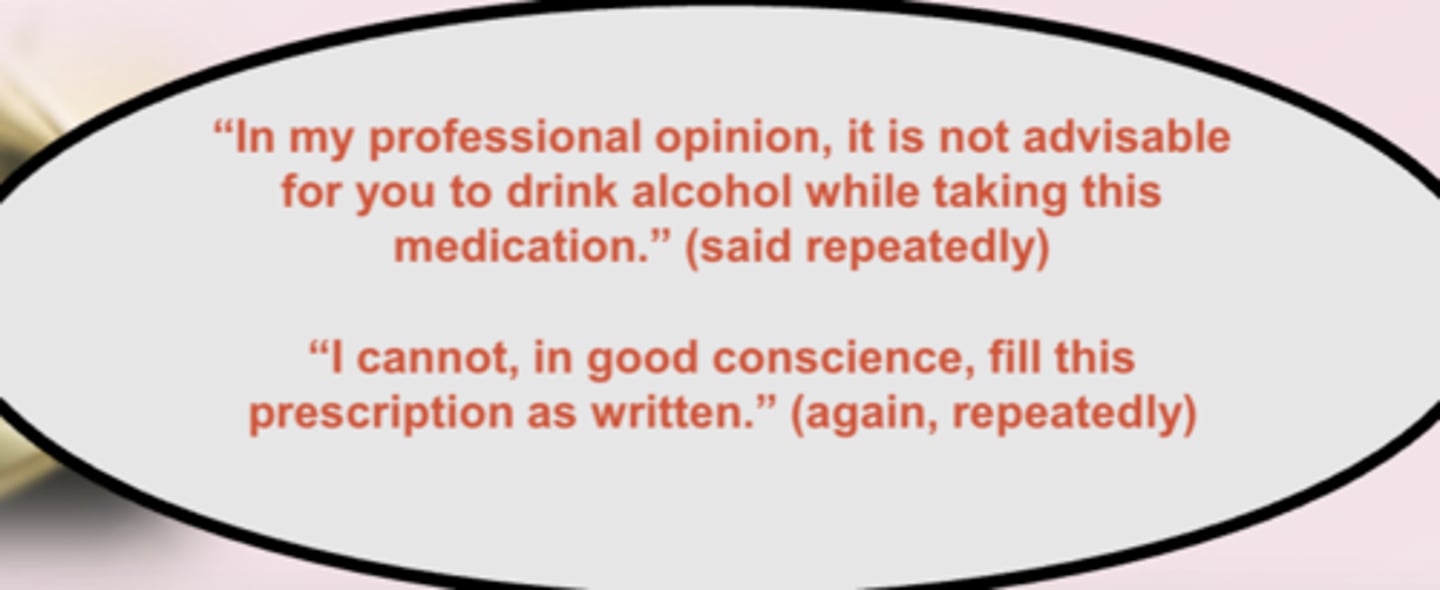
Fogging
- accepting manipulative criticism by calmly acknowledging to your critic the probability that there may be some truth in what he or she says
- Aims to give a minimal, calm response using terms that are placating but not defensive, while at the same time not agreeing to meet demands
- remain your own judge of what you do during the situation

Negative inquiry
- actively promoting criticism to use the info (if helpful) or exhaust it (if manipulative)
- prompting your critic to be more assertive and less dependent on manipulative ploys

Workable compromise
- may be practical to offer a workable compromise to the other person
- can always bargain for your material goals unless the compromise affects your personal feeling or self-respect
- in the end goal involves a matter of your self-worth, however, there can be no compromise
- use whenever you feel that your self-respect it not in question

Sorting issues
- several issues will become sandwiched together
- unless these issues or messages are sorted out and dealt with separately, the individual may begin to feel confused, anxious, and overwhelmed
- it is to the assertive individual's and the recipient's advantage to deal with these issues separately

Disarming anger
- extremely useful protective technique
- offered to another person exhibiting a lot of anger and who may bordering on physical violence
- writing down an angry person's comments will often help to defuse the anger-slows person down, cant write as fast as they yell; will choose words more cautiously when a record is being kept
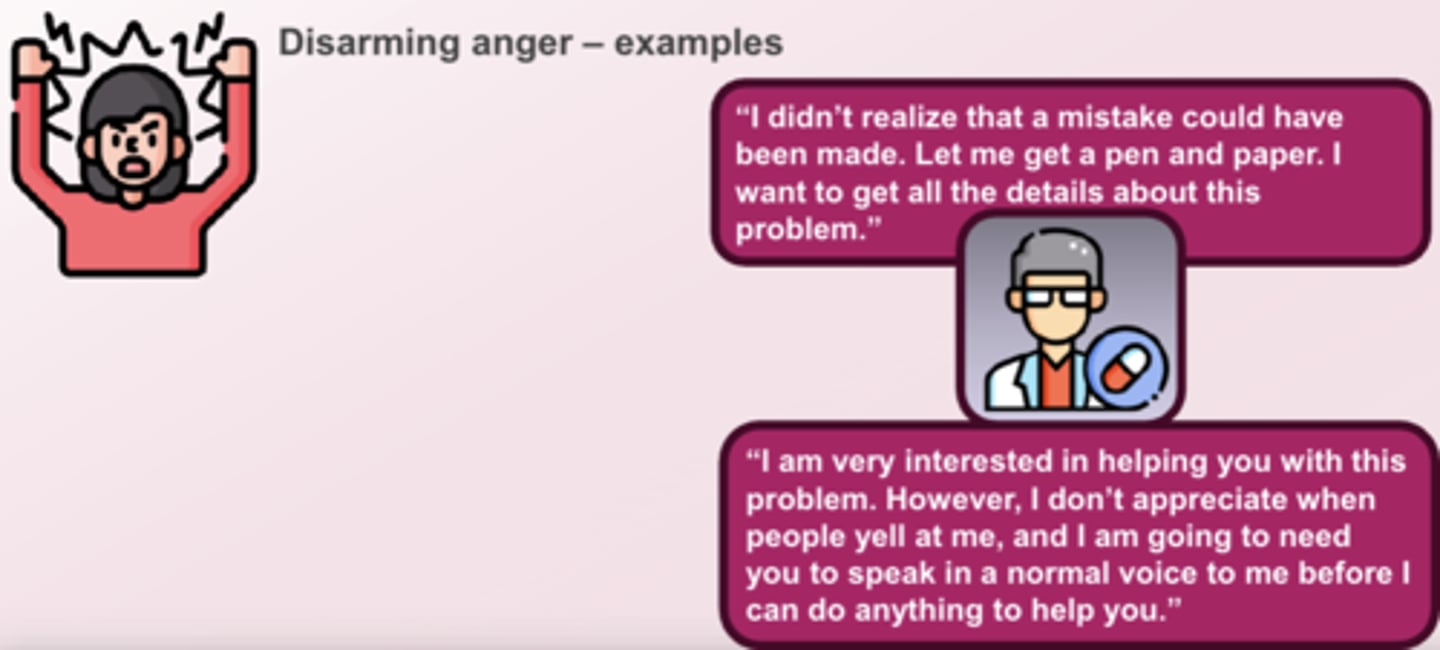
Disarming anger: Agree that you will talk about...
whatever issue the other person wants, but only after some of the anger dissipates
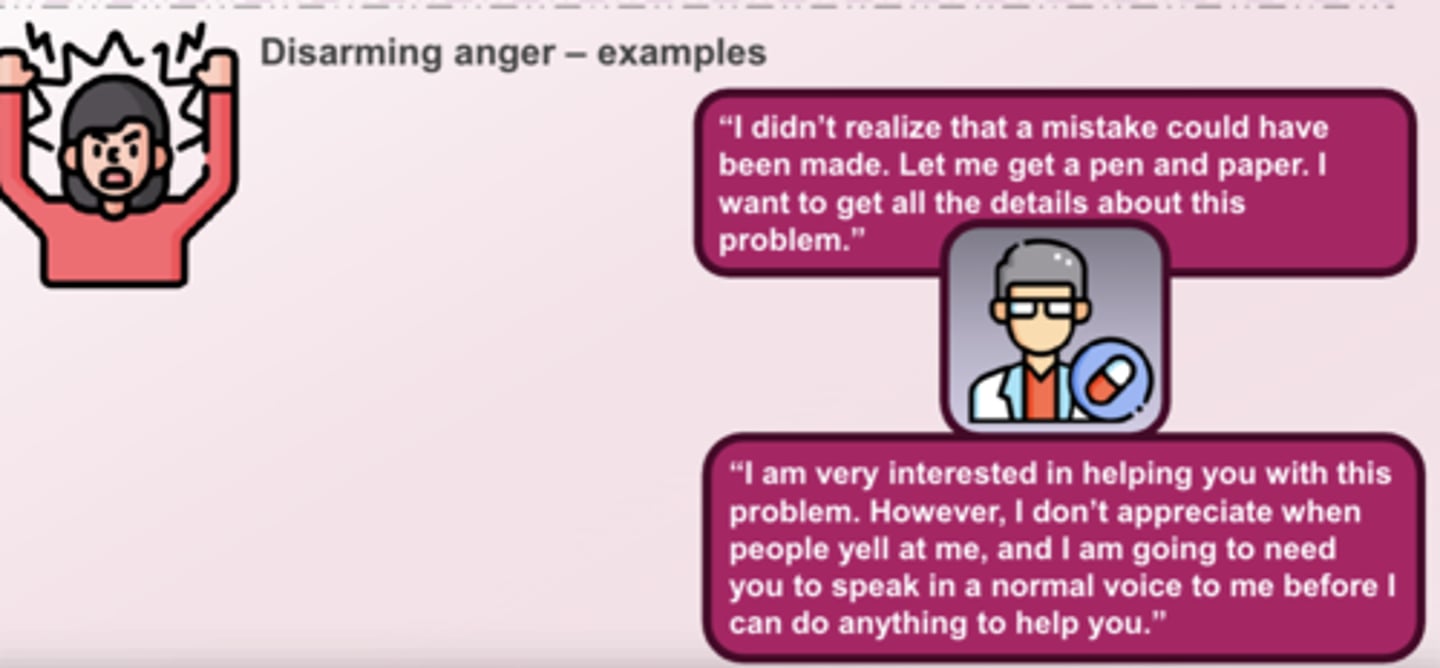
Selective ignoring
- involves deciding to address or not address specific content from another individual
- replies are not given to unfair or abusive interactions, but only to statements that are not destructive, guilt-producing, prejudicial, or unjust

Assertive withdrawal
- What does it involve?
- What can it be accomplished by?
- What does it reinforce?
- involves a clear verbal or nonverbal signal that indicates you are postponing or terminating a conversation
- walking away, hanging up the phone, nonverbally removing your attention by starting other work
- Reinforces the verbal message that the conversation has ended
- approach this in a professional and calm manner

Assertive withdrawal is a drastic measure that should only be used when...
a situation is clearly out of hand
Assertiveness is an essential strategy for managing what?
managing conflict
One must also commit to knowing __________________ in addition to understanding and practicing your _____________ rights
- personal style
- assertiveness